
Some of the links on this page may link to our affiliates. Learn more about our ad policies.
Best Wireless TV Headphones for Seniors
Updated on: January 2023
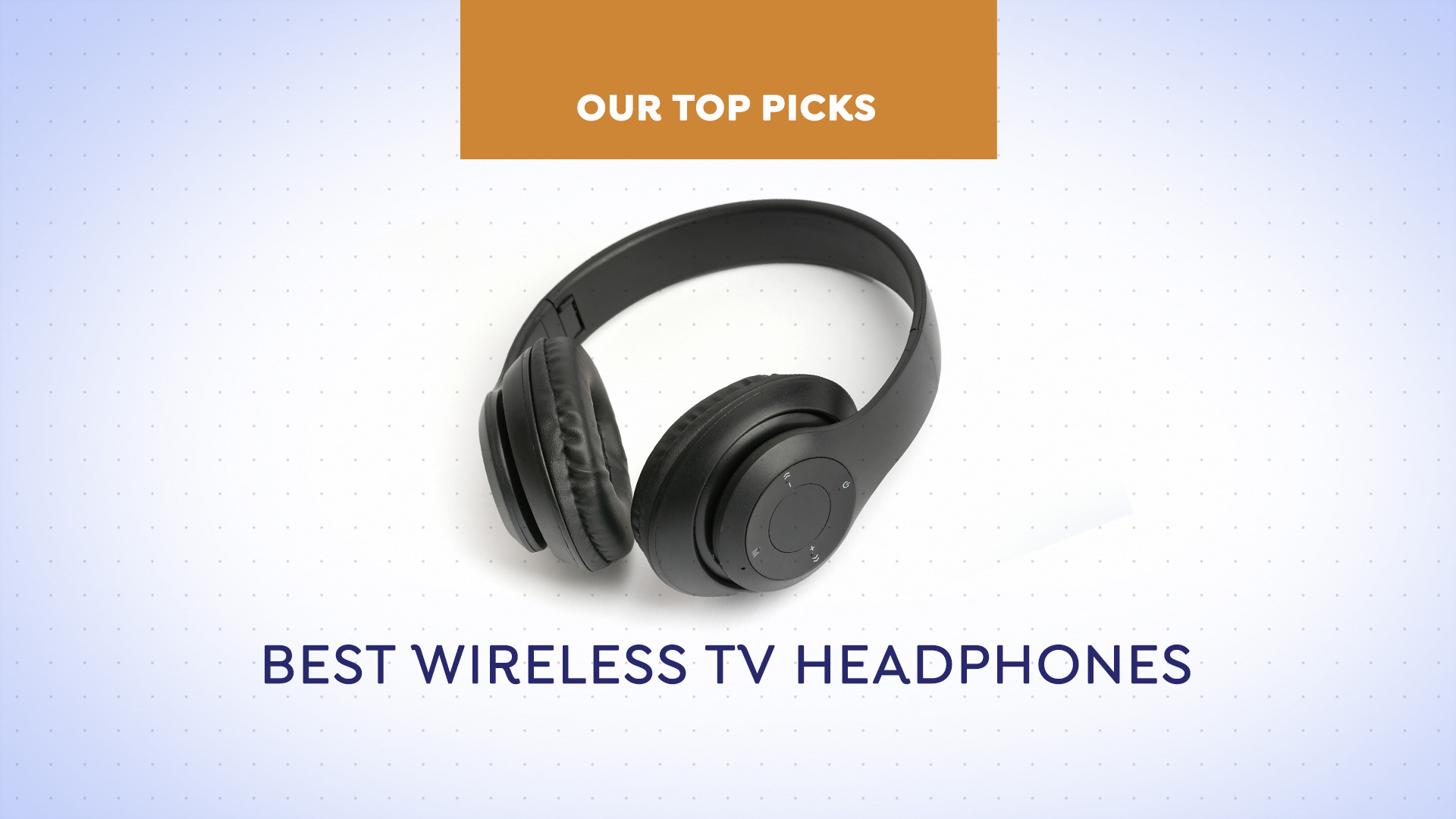
Our Top TV Headphones for Senior Picks
Best Overall

Audio Range OTE-1000 Wireless TV Headphones
Best Battery Life
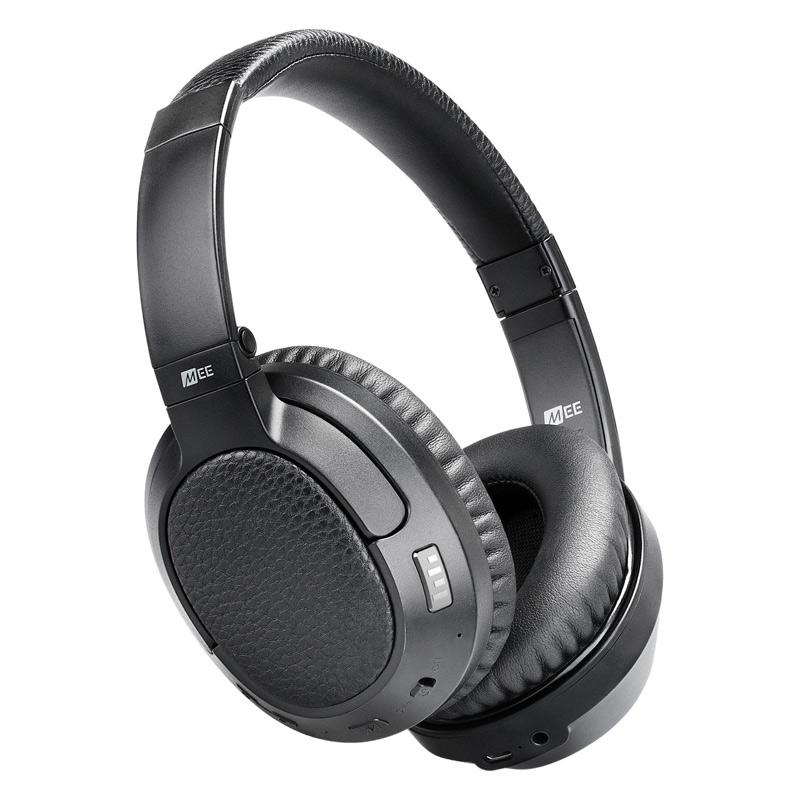
Mee Audio Matrix Wireless Headphones
Best with Bluetooth

Avantree Ensemble Wireless Headphone
Struggling to hear the TV headphones for seniors and follow dialogue is a common complaint for seniors with hearing loss, but it may also be hard on your family as well! Everyone has different preferences and schedules, and when you want to watch the TV, your partner or family may be sleeping or working. You may also be sitting too close to the TV in order to hear it better, leading to back pain and neck strain. These problems can be easily solved through the use of wireless TV headphones for seniors.
Good quality TV headphones for seniors can produce wide frequencies of sound so that you can enjoy both dialogue and music on your favorite programs. More importantly, they’re also comfortable so that you can wear them and then forget them.
If you’re afraid of set-up or if your TV may not be compatible, the majority of wireless headphones today offer plug-and-play connectivity that doesn’t require extra pairing steps. There are even more benefits you can enjoy that we’ll address in the guide.
With this in mind, read on for our buyer’s guide some of the best wireless TV headphones today!
Find What You Need
Types of Wireless TV Headphones for Seniors
It’s first helpful to know that there are several different types of wireless TV headphones for seniors. As you read this brief guide on each one, consider your own lifestyle and how each of their features and benefits could improve your TV-watching experience.
Over-Ear Headphones
Over-ear headphones are usually the biggest headphones you can find at the store. Since they’re so big, this means that they’re hard to pack and travel with. However, these wireless TV headphones for seniors make up for that by presenting some of the best sound quality money can buy with deep basses and highs that aren’t tinny.
Since over-ear headphones fully cover your ears when they’re worn, they are comfortable to wear for long periods of time without your ears getting sore. On the downside, higher quality over-ear headphones may be heavy, so it’s important that you find one with a padded headband for extra comfort.
On-Ear Headphones
Over-ear headphones are placed around your entire ear while on-ear headphones rest directly on top of your ears. If you don’t like the feeling of your entire ear being enveloped by the ear cups, this can be a good option for you. On-ear headphones are also far more portable and tend to be lighter than over-ear headphones.
You’ll find that the sound quality can be just as good as over-ear wireless TV headphones for seniors, but it does depend on the brand that you purchase. You’ll also need to be aware that there’s less noise isolation since the ear cups can’t lay flat around your ears.
If you find that your ears get sore easily from headphones pressing against your ears, these headphones may not be the best for long bouts of TV viewing.
In-Ear Headphones
In-ear wireless headphones are also known as “earbuds” because of their unique shape. These are some of the most common headphones because they come with every new iPhone, and they’re highly portable because of their small size.
The main caveat to earbuds is that they can become highly uncomfortable to some people because of the way they fit into your ear canal. For this reason, it’s recommended to avoid purchasing earbuds made solely from hard plastic.
Since in-ear headphones come in a range of prices–to affordable ones you can pick up at a drugstore to high-end models that costs hundreds of dollars–their performance can vary.
Overall, most earbuds won’t produce the range of frequencies that on-ear and over-head headphones are capable of creating. However, you may not tell the difference unless you’re a sound aficionado.
Bone Conduction Headphones
Bone conduction headphones are the best kind of headphones for people who are hard of hearing because they don’t rely only on the eardrum. The reason for this is because of the way the technology works.
By resting on the listener’s cheekbones, sound is instead transmitted through vibrations in the bones of your head and jaw. This enables the information to bypass your eardrum and go directly to your inner ear.
One of the main complaints about these types of headphones is that your ear is completely exposed. This means that you won’t enjoy the same clarity of sound that other headphones are able to achieve. And since the sound completely bypasses your eardrums, the audio quality isn’t the best.
However, these are still a great option for people who are hard of hearing or who wear hearing aids and can’t find TV headphone that fits them correctly.
Open-Back VS Closed-Back Headphones
You’ll also come across open-back and closed-back headphones. The difference between these is the quality of the sound.
Closed-back headphones are what you’re used to seeing in stores. The closed ear cup design helps eliminate any peripheral noises around you so that you can focus on only the sounds coming from your headphones. However, this doesn’t necessarily mean that these headphones block out all noise.
Open-back headphones can be a great choice if you’re not worried about other people hearing the noise coming from your headphones. With the way the ear cups are designed with an open back, a more open and airy sound is created while you’re listening to your shows.
This creates a sound that’s similar to listening to your TV speakers normally. Even better, on-ear headphones that are open-back usually don’t apply as much pressure to your ears, meaning that you can wear them longer without feeling any pain.
Noise-Cancelling Headphones
If you like watching TV in a completely quiet environment, or you’re concerned about family members still being able to hear the noise coming from your headphones, then we recommend looking into noise-cancelling headphones.
As the name suggests, these kinds of headphones have built-in technology that reduces the sound you hear from outside the headphones. It does this through a small mic on the outside of your headphones that measures the frequencies of your surroundings. It then creates an opposite frequency in order to cancel it out.
Any type of headphone can be combined with noise-cancelling technology, However, closed-back, over-ear headphones that are also noise-cancelling will give you the most soundproof environment. This also makes them perfect for air travel.
Bluetooth Headphones
When we talk about wireless headphones, we mean Bluetooth. One of the main complaints people have with either wired in-ear or over-ear headphones is that the wire easily tangles. This is a large problem with earbuds in particular, as they can fit in pockets and bags easily, making them more prone to tangling.
Bluetooth headphones help resolve this issue by becoming completely wireless. This means that it’s possible to get up while watching your show without being tethered to your device. You can even move to another room, and they can still work effectively.
It’s important to know that you won’t be getting the same sound quality as wired headphones. However, as Bluetooth technology has expanded, the difference between wired and wireless headphone sound is becoming harder to discern.
Radio Frequency Headphones
If you want a wireless headphone but you’re looking for something other than Bluetooth, there are also radio frequency headphones available. These headphones usually come with their own RF transmitter that enables you to connect to your TV.
The setup is usually just as easy as Bluetooth headphones, as the RF transmitter or docking station will connect to any device that has RCA audio output. This makes this a great option if your TV isn’t capable of connecting to Bluetooth, and you don’t want to purchase an additional bluetooth adapter.
However, one of the main caveats with radio frequency headphones is their susceptibility to interference. This means that radios, phones, and microwaves may interrupt your viewing experience.
Infrared Headphones
If you want wireless headphones but the same sound quality as wired, then we recommend looking into infrared headphones. Not only do they produce great sound, but you also don’t have to deal with the occasional interference that you do with radio frequency headphones.
However, it’s important to remember that infrared is a line-of-sight technology. This means that your range is limited, and you’ll need to stay within the same area as your television.
These headphones also need an IF transmitter to operate, and there needs to be an unobstructed, clear line of sight between the transmitter and the headphones for them to work properly. This may be hard to achieve depending on the layout of your room.
Hearing Aid Compatible Headphones
Now that you know the main types of headphones, can you wear any of them if you also have hearing aids? The answer is yes. However, it’s important to remember to keep the volume at safe levels in order to avoid further degradation of your hearing.
For this reason, it’s often recommended to go with noise-cancelling headphones if you have hearing aids. This is because people are often tempted to turn the headphone volume up to dangerous levels because of the environmental sounds around them. With noise-cancelling headphones, it’s easier to keep the volume at a safe level with hearing aids.
Here’s a brief overview of the type of headphones that are best with your type of hearing aid:
Bone-Conduction Headphones
- In-the-ear (ITE)
- In-the-canal (ITC)
- Completely-in-canal (CIC)
- Invisible-in-canal (IIC)
On-Ear Headphones
- Completely-in-canal (CIC)
- Invisible-in-canal (IIC)
- In-the-ear (ITE) (Feedback may occur)
- In-the-canal (ITC) (Feedback may occur)
Over-Ear Headphones
- In-the-ear (ITE)
- In-the-canal (ITC)
- Completely-in-canal (CIC)
- Invisible-in-canal (IIC)
- Behind-the-ear (BTE) (Feedback may occur)
- Receiver-in-canal (RIC) (Feedback may occur)
Unfortunately, you won’t be able to wear earbuds with hearing aids. People with BTE and RIC hearing aids can also look for extra large over-ear headphones in order to try and avoid feedback, also known as circumaural headphones.
Watching TV with Hearing Impairment
Now that you’re more knowledgeable about the different types of wireless TV headphones for seniors available, how can they improve your lifestyle if you’re living with a hearing impairment? Here are some of the benefits you can enjoy:
Watching Untethered
We recommend wireless headphones because you’ll be able to watch comfortably and untethered. If you need to adjust your seating position or get up and get a drink, you won’t have to worry about the extra step of unplugging your headphones.
If your couch or armchair is far away from your television, long wired headphones may present a tripping hazard. You may also have to sit uncomfortably close to your television.
Noise Reduction
If you live in a noisy area or with several people, you know that watching the TV at a comfortable sound level can sometimes seem impossible. With wireless headphones, you’ll be able to watch in comfort without needing subtitles on 24/7.
While all headphones will provide some level of noise reduction, you can also consider purchasing noise-cancelling headphones for full immersion.
Improved Relationships
Sometimes finding the right time to watch TV can be hard if you’re living with people who are still working from home. Other times, you may want to watch while other people are sleeping.
Wireless headphones can reduce friction in the home and present a win-win situation–you’ll be able to watch TV without distracting your loved ones.
Comfort
Since manufacturers recognize that you’ll be wearing your wireless headphones for longer amounts of time as you watch TV shows and movies, they’re motivated to make them as comfortable as possible.
Many headphones are lightweight and made of soft material so that you can wear them without getting sore or uncomfortable, regardless of whether they’re over-ear or in-ear.
Best Wireless TV Headphones for Seniors
Now that you know about all the different types of wireless TV headphones for seniors as well as what would work best if you wear hearing aids, it’s time to make your purchase decision! We’ve based our reviews through unbiased research on a number of factors, such as customer reviews, sound quality, cost, comfort, warranty periods, and more.
After you read our reviews, it’s important to read the product’s reviews as well as description yourself. You may also be able to walk into your local tech store and try on the headphones yourself. Even if a product is five stars, it’s also important that you feel comfortable wearing it for long amounts of time.
AudioRange
AudioRange OTE-1000 Wireless TV Headphones
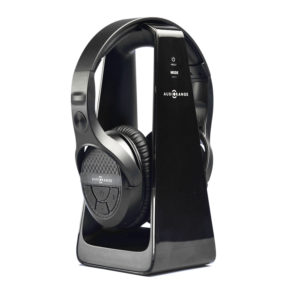
- Large intuitive buttons
- Includes a one-year limited warranty
- 10 hour usage time
- Lighter than other headphones
- No pairing required
If you’re looking for a pair of high-quality wireless TV headphones for seniors at a reasonable price, our top recommendation is the AudioRange OTE-1000. They’re currently on sale for $109.99.
The first striking detail about these headphones is that they come with an attractive pyramid-shaped dock. When you’re not using them, they’ll look good on any table or entertainment system.
Another unique aspect of the headphones is that they are specially tuned for seniors to hear voice audio more clearly, compared to other headphones that focus on gaming or perfect sound stage reproduction. Moreover, it has an impressive range of 100 ft indoors which means you can walk around the room and adjust your position without any worry about a drop in sound quality.
Last but not least, a 2.4 GHz frequency means that these headphones are low-latency. You will experience little to no interference at this frequency, and headphones on this radio frequency have higher-quality sound than Bluetooth is capable of producing.
When you’re watching TV, this translates into no lip-sync delays!
Mee Audio
Mee Audio Matrix Cinema ANC Bluetooth Wireless Active Noise Cancelling Headphones
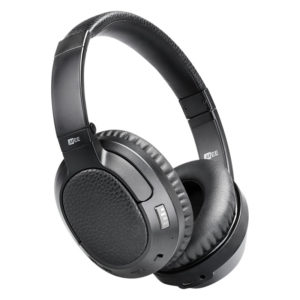
- Built-in headset to answer calls
- Folds flat for convenient travel
- Cable included to be used as a wired headphone
- Status notification lights can be disabled
- Memory foam pads for comfort
Noise-cancelling headphones are our top recommendation for people with hearing aids in order to avoid turning up the volume to excessive levels. These over-ear wireless TV headphones for seniors are also comfortable for most hearing aids.
We were impressed by the number of features that these headphones come with for the price of $149. CinemaEAR enhances the audio of any music or show you’re watching by allowing you to switch between several different profiles.
One of the best features of these headphones is that they boast an impressive battery life of up to 33 hours with noise-cancelling off. They’ll also last up to 20 hours with noise-cancelling on with a charging time of two hours.
However, we wouldn’t recommend these headphones if you find over-ear headphones uncomfortable. Noise-cancelling is also a feature that isn’t necessary in order to enjoy high-quality audio.
If you have issues hearing dialogue, the inclusion of Clear Voice Mode does more than boost the volume–the brand also claims that it improves clarity and speech intelligibility. These headphones also include a number of other features.
Avantree
Avantree Ensemble Wireless Headphone for TV Watching

- Low latency
- Multi-format audio support
- Affordable $89.99 price
- Numerous five-star reviews
- Works with most TVs
Bluetooth is one of the top technologies to use for wireless TV headphones for seniors because most televisions today have Bluetooth connectivity built-in. Even if your TV doesn’t, it’s easy to purchase and plug-in an adapter.
These Avantree headphones are one of the best when it comes to Bluetooth, as they have Bluetooth 5.0 which enables you to simply “plug and play.” Your headphones will automatically pair with any nearby Bluetooth-enabled devices without any extra steps.
We also appreciate the fact that you never have to worry about recharging your headphones. It comes with a dock so that when you’re done using them, you simply place them back on the dock. When fully charged, Avantree Ensemble headphones can last a full 35 hours.
AudioRange
Audio Range ITE-1000 in-Ear TV Headphones
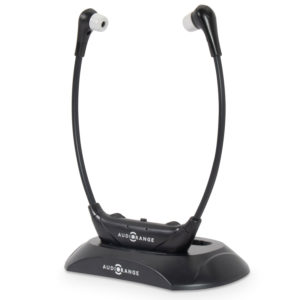
- Flexible 100 ft range
- 2.4 GHz frequency
- 30-day money back guarantee
- One-year limited warranty
- 10 hour battery life
In-ear headphones are notorious for being uncomfortable, but if you’re looking for the rare pair that doesn’t follow this trend, we recommend Audio Range. These in-ear wireless TV headphones for seniors fit comfortably in your ear canal with the dock hanging below in front of your chest or behind depending on your preference.
Two of the main benefits is that no pairing is required, and you won’t experience any lip-sync delay while you’re listening.
Unfortunately, in-ear headphones are compatible with hearing aids. Although the brand claims it’s compatible with nearly every TV on the market, it’s still recommended to check to make sure by looking through their support guide.
With a normal price of $159.99 and on sale for $129.99, we believe both prices are fair due to the number of features and quality of the product.
Sennheiser
Sennheiser RS 5000

- Adjust left and right volume to balance the sound
- Has a range of up to 70m
- 12 hours of playing time
- Ultra-light
- Reminds you when it’s time to charge the battery
If you don’t like the feel of over-ear or on-hear headphones but you don’t want to sacrifice sound quality, we recommend taking a look at the Sennheiser RS 5000. At $249.95 these are premium headphones that provide multiple hearing profiles in order to enhance your shows or music.
The Speech Intelligibility function dynamically reduces background noise that’s part of the show without ruining the experience. You’ll be able to hear dialogue clearly without needing the aid of subtitles.
We were also impressed by the emphasis on comfort and style–these are lightweight wireless TV headphones for seniors that include a docking station that has a minimal profile when placed on your table.
Because of the lightweight build, we feel that even people who don’t like earbuds may find something to like in these headphones. However, at $249 it may be cost-prohibitive for many.
Jelly Comb
Jelly Comb YH690 Wireless TV Headphone
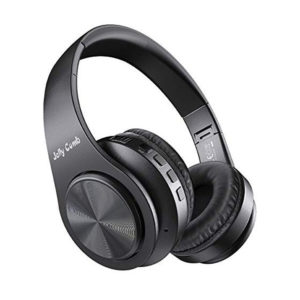
- Compatible with 99% of TVs on the market
- 15 hours of battery life on one charge
- Auto connection for “plug and play”
- One transmitter works with multiple headphones
- Over a hundred five-star reviews
If you’re looking for affordable headphones that still produce decent quality sound, look no further than this Jelly Comb model. At only $59.99, this is an affordable price for over-ear headphones that still include numerous features. If you’re worried about sound quality at this price, the brand claims that the headphones produce clear and loud stereo sound with no statics.
We also appreciate the emphasis on comfort with soft skin earpads and an adjustable, leather-wrapped headband. This means that you can watch for long amounts of time without feeling uncomfortable by cumbersome headphones.
These wireless TV headphones for seniors also have the ability to stay connected for up to 98 ft. The main con to these headphones is that they come with an RF transmitter, so if you want headphones that work through Bluetooth, you’ll need to look elsewhere. There is also the chance of running into some interference from nearby devices when it comes to using radio frequency headphones.
Conclusion
When it comes to purchasing your first pair of wireless TV headphones for seniors, the number of choices may seem daunting at first. We recommend considering your comfort and lifestyle first before narrowing down your choices. For instance, if you have hearing aids, you’ll want to consider over-ear or on-ear headphones depending on what kind of hearing aids you have.
Next, consider your budget and the sound quality you’re expecting. Higher-end models tend to cost upwards of $200, but you’ll enjoy a large range of sound frequencies as well as several sound profiles to switch between depending on the type of media you’re listening to.
This can be extremely helpful if you have trouble hearing dialogue, as many higher-end headphone models come with the ability to isolate dialogue by quieting the background noise of shows or movies.
Last but not least, if you’re not used to on-ear or over-hear headphones, we recommend trying some on at your local tech store. This will give you a good idea of what to expect for the headphones that you’re interested in and whether you feel comfortable.
Once you purchase your headphones, you’ll find that watching television is a far more comfortable experience–especially if you live in noisy areas or live with loved ones. No matter what your schedules are, you can enjoy music, movies, or a show without distracting them or waking them up.
Even better, wireless headphones for seniors give you the flexibility to watch TV in comfort and walk around or outside the room without needing to completely disconnect from the show you’re watching.

